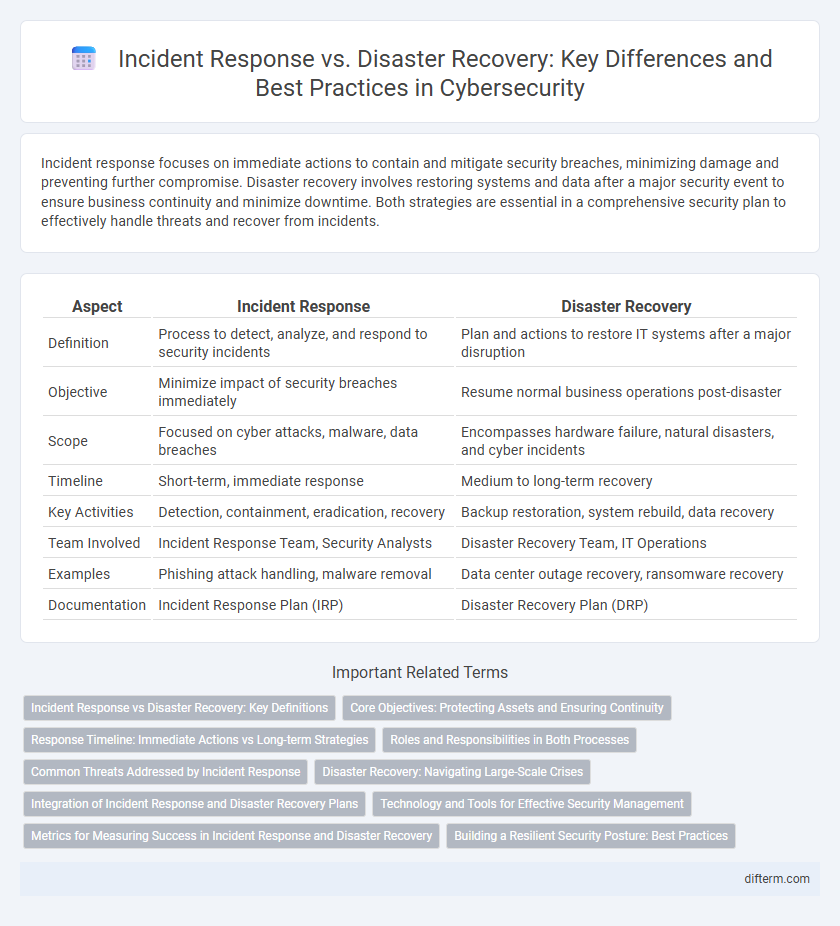Incident response focuses on immediate actions to contain and mitigate security breaches, minimizing damage and preventing further compromise. Disaster recovery involves restoring systems and data after a major security event to ensure business continuity and minimize downtime. Both strategies are essential in a comprehensive security plan to effectively handle threats and recover from incidents.
Table of Comparison
| Aspect | Incident Response | Disaster Recovery |
|---|---|---|
| Definition | Process to detect, analyze, and respond to security incidents | Plan and actions to restore IT systems after a major disruption |
| Objective | Minimize impact of security breaches immediately | Resume normal business operations post-disaster |
| Scope | Focused on cyber attacks, malware, data breaches | Encompasses hardware failure, natural disasters, and cyber incidents |
| Timeline | Short-term, immediate response | Medium to long-term recovery |
| Key Activities | Detection, containment, eradication, recovery | Backup restoration, system rebuild, data recovery |
| Team Involved | Incident Response Team, Security Analysts | Disaster Recovery Team, IT Operations |
| Examples | Phishing attack handling, malware removal | Data center outage recovery, ransomware recovery |
| Documentation | Incident Response Plan (IRP) | Disaster Recovery Plan (DRP) |
Incident Response vs Disaster Recovery: Key Definitions
Incident response involves immediate actions taken to identify, contain, and mitigate security breaches or cyberattacks to minimize damage and restore normal operations. Disaster recovery focuses on the broader strategy and processes for restoring IT systems, data, and infrastructure after significant disruptions such as natural disasters or major cyber incidents. Effective security management integrates incident response for rapid threat handling and disaster recovery for long-term system resilience and business continuity.
Core Objectives: Protecting Assets and Ensuring Continuity
Incident response centers on promptly identifying, containing, and mitigating security breaches to protect critical assets from immediate harm. Disaster recovery focuses on restoring IT infrastructure and operations swiftly after significant disruptions to ensure business continuity. Both strategies prioritize minimizing downtime and safeguarding data integrity to maintain organizational resilience.
Response Timeline: Immediate Actions vs Long-term Strategies
Incident response involves immediate actions such as identifying, containing, and mitigating security breaches to minimize damage within minutes or hours. Disaster recovery focuses on long-term strategies including data restoration, system rebuilding, and business continuity planning that may span days or weeks. Efficient cybersecurity programs integrate both timelines to ensure rapid response and sustained recovery from incidents.
Roles and Responsibilities in Both Processes
Incident Response teams focus on identifying, containing, and mitigating security breaches, with roles including incident handlers, forensic analysts, and communication coordinators. Disaster Recovery teams are responsible for restoring IT infrastructure and business operations after a major disruption, involving roles such as recovery managers, system administrators, and backup specialists. Clear delineation of responsibilities ensures efficient coordination between incident containment and system restoration during security events.
Common Threats Addressed by Incident Response
Incident response primarily addresses cyber threats such as malware infections, phishing attacks, ransomware, and data breaches, aiming to quickly contain and mitigate damage. Security teams analyze suspicious activities to prevent escalation and preserve evidence for forensic investigations. Effective incident response minimizes operational disruption and strengthens organizational resilience against evolving cyber threats.
Disaster Recovery: Navigating Large-Scale Crises
Disaster recovery focuses on restoring critical IT infrastructure and data access following large-scale crises such as natural disasters, cyberattacks, or system failures. Emphasizing data backup, redundant systems, and failover mechanisms ensures minimal downtime and business continuity. Effective disaster recovery plans integrate with broader enterprise risk management and compliance frameworks to mitigate financial and operational impacts.
Integration of Incident Response and Disaster Recovery Plans
Integrating Incident Response and Disaster Recovery plans ensures a seamless transition from immediate threat mitigation to long-term system restoration, minimizing operational downtime and data loss during cyber incidents. Coordinated strategies enhance communication between security teams and IT departments, accelerating recovery timelines and reinforcing overall organizational resilience. This alignment supports comprehensive risk management by addressing both technical containment and business continuity objectives simultaneously.
Technology and Tools for Effective Security Management
Incident response leverages real-time monitoring tools, automated alert systems, and forensic analysis software to rapidly detect and mitigate security breaches. Disaster recovery relies on backup solutions, cloud-based recovery platforms, and failover technologies to restore critical systems and minimize downtime after catastrophic events. Integrating Security Information and Event Management (SIEM) with automated incident response tools ensures comprehensive security management and faster recovery processes.
Metrics for Measuring Success in Incident Response and Disaster Recovery
Effective incident response is measured by metrics such as mean time to detect (MTTD), mean time to respond (MTTR), and the percentage of incidents resolved within defined service level agreements (SLAs). Disaster recovery success relies on recovery time objective (RTO), recovery point objective (RPO), and the frequency and success rate of recovery drills or failover tests. Monitoring these KPIs provides organizations with actionable insights to enhance their overall security posture and minimize operational disruptions.
Building a Resilient Security Posture: Best Practices
Effective incident response involves rapid detection, containment, and mitigation of security threats to minimize damage and restore normal operations quickly. Disaster recovery focuses on comprehensive plans and technologies to recover critical systems and data after significant disruptions, ensuring business continuity. Integrating both strategies with regular testing, updated protocols, and employee training builds a resilient security posture capable of withstanding and recovering from diverse cyber incidents.
Incident Response vs Disaster Recovery Infographic

 difterm.com
difterm.com